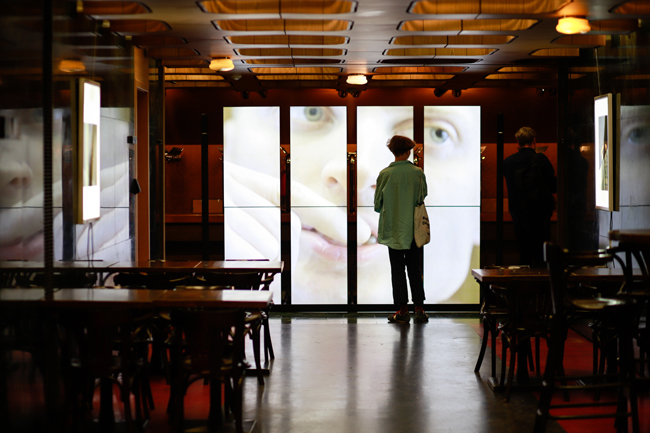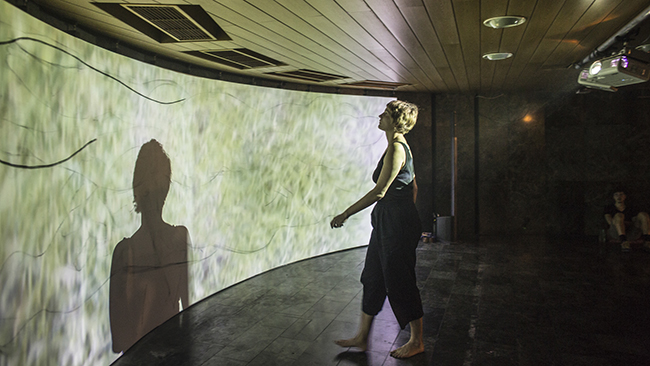
Awaiting the opening of Kunsthalle Praha
07/01/2019

Living Kunsthalle. Centones. Photo: Fabiana Mertova
An art space is being built in Prague right now that is currently one of the most talked about and debated projects on the central European art scene – Kunsthalle Praha, the private initiative of Czech art collector Petr Pudil. A symbolic ringing in of the new art space took place on the evening of 16 June, at Prague’s National Theatre New Stage (Nova Scena). Built in 1983 and known as one of the most provocative architectural specimens in the city, the building hosted The Pudil Family Foundation’s first organised project titled Living Kunsthalle, in which the theatre was transformed into a creative laboratory focused on performance. The organisers emphasise that the event’s goal was to explain and outline the vision that they have for the Pudil Family Foundation’s Kunsthalle Praha. Slated to open in spring 2021, it’s been a hot albeit rather enigmatic topic among the city’s artistic literati ever since reconstruction began on on the former Zenger transformer substation. ‘The Living Kunsthalle performance evening was designed to give people the chance to know what's going on. Although the building is currently undergoing reconstruction, it is surrounded by curiosity. It therefore seemed like a great idea if we could present the programme before the centre’s official opening – so that we could explain our intentions and plans in our own way,’ explains Kunsthalle Praha Chief Curator Christelle Havranek. She continues: ‘We are very happy that the National Theatre Nova Scena agreed to be our partner. You see, one of our missions is to collaborate with others in which we think and work together so that we can create broader partnerships with other cultural institutions besides just visual art institutions. In this case, we decided to present visual artists in the surroundings of a theatre. It's important to know that these artists are not only performers. Some of them don’t even do performances all that much, and most of them have never done one in a theatre. Up til now, their presenting environment had only consisted of galleries or museums.’

Living Kunsthalle. Candy Shop. The Circus. Photo: Fabiana Mertova
On the evening of 16 June, the conceptual support for the event was decidedly sound-based. The goal of the project’s international team of six artists – Lina Lapelyte (Lithuania), Hicham Berrada (Morocco/France), Roman Štětina (Czechia), Xavier Veilhan (France), Haroon Mirza (UK), and Adéla Součková (Czechia) – was to fill the several stories of the venue’s foyer, its cafe, and the large stage with the visualisation of sound. Starting off the evening was Lina Lapelyte, having just recently returned from the Venice Biennale, where her co-creation for Lithuania’s national pavilion was awarded the Golden Lion. Together with a group of musicians and singers, Lapelyte performed Candy Shop – the Circus, in which ‘dirty rap’ lyrics were transformed into lullabies by way of an amalgamation of video, voices, electronic music, and beating drums, with the red uniforms of a drum band briefly cutting across the minimalistic black and white stage set. Later on, Xavier Veilhan performed on the same stage his hour-long piece, SYSTEMA OCCAM, a visual rendering of the work of French electronic music pioneer Eliana Radigue. French-Moroccan artist/scientist Hicham Berrada generated chemical landscapes (titled Présage) in the foyer, by the entrance to the main stage. The works of Czech artists Adéla Součková and Roman Štětina, Landing and Centones, respectively, were specially commissioned for the event and were on view throughout the evening. Lastly, late in the night, Living Kunsthalle came to an end with a multimedia performance by Haroon Mirza.
.jpg)
Living Kunsthalle. Emerging Paradigm. Photo: Fabiana Mertova
The following day, Petr Pudil, who prefers being called an art activist rather than a collector, said of the event: ‘It’s a great day for us. We’ve been working on the Kunsthalle Praha project for a long time, and yesterday gave people the chance to see at least some of the outcome of what it is that we are doing. It’s nice to see a result. It was a very big moment. It was a great event and I think it was unique for Prague. So many people came out to see it, and I have a feeling that the audience responded very positively, despite the fact that performance is not a genre that enthralls the masses. It’s not for everyone.’

Living Kunsthalle. Landing. Photo: Dita Havrankova
.jpg)
Living Kunsthalle. SYSTEMA OCCAM. Photo: Fabiana Mertova
The authors of the idea for Kunsthalle Praha are Petr Pudil and his wife Pavlína. At present, the building that will house the future art foundation – the former Zenger transformer substation – is a construction site hidden from the public eye by the neoclassical facade of the building built between 1930 and 1931. At one time, the only occupant of the cavernous indoor space was the substation’s technical equipment. As the architects of the project, the Czech architectural firm Schindler Seko, recount, the building never even had a proper entryway – just a very small side door. Due to technological advancement, today the transformers sit in a modestly sized box, still onsite, and continue to perform their function. The architects have envisioned a symbiosis of historical and contemporary architecture in which the restored historical legacy, with all of its details, organically interlaces with a space for modern art. The performances of 16 June serve as a striking representation of the strategy and concept of the forthcoming institution. ‘We decided that it should be an international project. It features artists from various countries as well as Czech artists. This is exactly the way we want to work in the future,’ says Christelle Havranek. Petr Pudil emphasises that the name of the planned space – Kunsthalle Praha – is already a clear indication of their intent. The joining of the German word ‘Kunsthalle’ with the Czech spelling of Prague is a testament to the foundation’s dual mission: to put the city on the European map of art capitals, and to contextualise the art of Czechia. Moreover, as Havranek says, ‘We can’t do it without bringing in another dimension. We will try to involve global artists and Czech artists in joint projects. We need to look more globally. In that way, we can provide the opportunity for people to see what is happening elsewhere in the world and, at the same time, create a reason for people to come here. This interaction between local and global should create something very dynamic. In Prague, you can often see exhibitions featuring the great Czech artists from the 1950s and 60s, but they lack context. There is no way for people to see the parallels with what was happening in the rest of the world, for instance, in Germany and the US, at that time. It’s important to recontextualise the art of that time – to bring back to this country some information about the rest of the world.’ The exhibition and activity programme for Kunsthalle Praha has been worked out up to 2024, and in truth, the institution is already carrying it out – not only with Living Kunsthalle, but also with the Facade Project, a public space project that is being currently presented on the facade of the building undergoing reconstruction. At the moment, one can see on it the large-format work Exit the Loop, by Adéla Součková, which draws the attention of passersby to the close relationship between the life of modern humans and virtual space.
_Adéla%20Součková%20-%20Exit%20the%20Loop_celek%20z%20boku_web_foto%20Oskar%20Helcel.jpg)
Kunsthalle Praha (Facade Project). Adéla Součková. Exit the Loop. Photo: Oskar Helcel